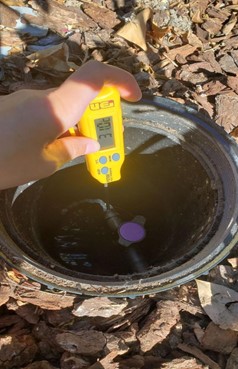This blog post provides an introduction to the recently published paper from Water Policy, and highlights some of the key features and findings of the research.
A field assessment of residential laundry to landscape greywater quality in the San Francisco Bay area
https://doi.org/10.2166/wp.2023.101
By Sara Khosrowshahi Asl, Katherine Cushing, Rachel O'Malley, Alexandra Dahl, Afshin Rouhani, Sherry Bryan, and Justin Burks
Lack of access to clean water is a global issue. With increasing droughts due to climate change, this is becoming an even more pressing issue, especially in areas such as California. In California’s urban regions, 36% of residential water usage is for outdoor use. Residential greywater reuse systems are a potential solution to reduce water use and improve water scarcity. Laundry-to-landscape systems reuse laundry greywater for irrigation. These systems generally produce safe and clean water that can be used to irrigate a range of plants.

Note: A Laundry to Landscape Greywater system (Credit: Author)
Scientists studied 30 of these systems in Santa Clara County, California. The systems studied ranged in age and whether or not they were compliant with California plumbing codes. The vast majority of the systems met California safety standards in regard to bacteria content, pH, salinity, dissolved solids, and more. This is important both for human and plant health. 83% met all of the regulations. In this study, many systems were deemed safer than systems in previous research studies.
The systems studied were also effective for irrigation. Households used their recycled water to irrigate various plants, including trees, shrubs, grass, fruit trees, vegetables, and herbs. About half of the plants watered using these systems were edible, and many were perennial and drought-tolerant. In addition, households did not change their landscaping after installing these systems.

Note: California Native plants being irrigated by greywater (Credit: Author)
These are the highlights of this research study:
- Samples from systems compliant with the California Plumbing Code had lower fecal coliform levels, and most chemical characteristics were in the acceptable reuse range for outdoor irrigation.
- Homeowners did not typically change their landscaping after installing greywater systems.
- Laundry to landscape programs provide an additional tool for water agencies to diversify regional water supply portfolios and conserve potable water.
Our analysis of greywater characteristics showed that among the 21 characteristics studied, most values fell into the acceptable range for wastewater reuse based on recommendations from the Food and Agriculture Organization and previous literature. pH values were slightly alkaline but within an acceptable range. Electrical conductivity levels were low, indicating low salinity, which is beneficial for plant growth. Sodium adsorption ratio and total dissolved solids values were also within acceptable ranges, suggesting moderate sodium content and dissolved substance concentration in the greywater. In most of our samples, the inorganic and organic contaminant concentrations were lower than the accepted ranges reported in the previous studies, except for potassium, iron, and calcium. System compliance was associated with fecal coliform levels, with non-code-compliant systems having higher levels.
Stakeholders can use our data to emphasize the importance of raising awareness about greywater reuse, promoting proper system maintenance, detergent selection, and plant choices, and actively engaging in education campaigns and training programs. It is worth noting that ongoing monitoring and evaluation of greywater systems are crucial for ensuring long-term performance. To validate and expand upon these findings, further studies should be conducted on a larger sample size, temporal scale, and across diverse locations to assess the long-term effects of greywater irrigation on plant health and soil and groundwater quality.

Note: Sara measuring the temperature at base of the Greywater outlet, covered around the mulch basin (Credit: Author)
More studies are still needed about these systems. Studying a larger number of systems in more locations for longer periods will help ensure the safety and longevity of laundry-to-landscape systems. Further research will also help spread this water conservation method to a wider range of locations.
